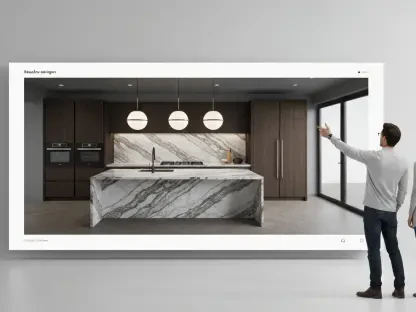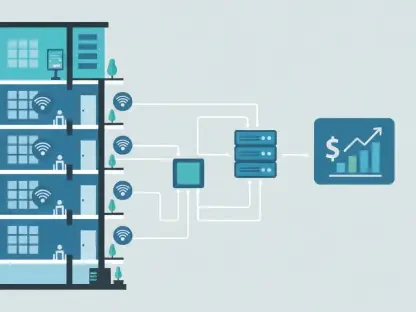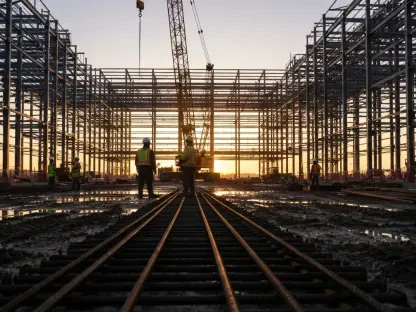Recent developments in technology have profoundly impacted various industries, with architecture experiencing some of the most radical changes. Architectural rendering software has become an invaluable tool in the architectural sphere, overshadowing traditional methods with digital innovations. These tools have transitioned from supplemental to essential, playing a pivotal role in visualizing and designing modern spaces. Architects, engineers, and planning authorities are now redefining cities and environments using these resources. The potential is substantial, offering enhanced precision, aesthetics, and user-friendly experiences that are revolutionizing idea conception and implementation, shaping physical spaces.
Market Dynamics and Growth Trajectory
Increasing Demand for Advanced Visualization Tools
The architectural rendering software market has seen a notable increase in demand as project complexity grows globally. Enhanced visualization tools are crucial for creating accurate and immersive designs, improving communication with clients and stakeholders. As of 2025, the market value of architectural rendering software was estimated at USD 2.47 billion, reflecting the high value placed on visualization technology. The continued rise in urban development and construction projects underscores the necessity of such tools, leading to their widespread adoption across the industry. The market is forecasted to achieve a USD 4.5 billion valuation by 2032, fueled by an annual growth rate of nearly 8%.
The crucial role of these tools lies in their ability to bring architectural concepts to life before any ground is broken, enabling architects to experiment with design iterations that can lead to more innovative and functional structures. Whether planning urban landscapes or conceptualizing the finer details of an interior space, rendering software facilitates a deeper understanding and appreciation of potential outcomes. This capability is particularly vital in large-scale urbanization and infrastructure projects where precision and foresight are crucial for success.
Integration with Emerging Technologies
Architectural rendering software has steadily integrated with new technologies, enriching the design ecosystem and enabling more integrated workflows. The incorporation of Building Information Modeling (BIM) into these tools provides a comprehensive model-based process that supports efficient planning, design, and construction of buildings and infrastructures. Architects now develop more precise representations and simulations that account for every phase of the project cycle, contributing to increased efficiency and cost-effectiveness.
Virtual Reality (VR) integration offers another layer of advancement, allowing stakeholders to virtually explore designs before they are brought to life. As more firms embrace VR, experiential design has gained prominence, resulting in more insightful client interactions and informed decision-making processes. The combination of BIM and VR has transformed architectural rendering from static presentation into dynamic, interactive experiences, bridging the gap between imagination and realization in engaging ways.
Technological Advances and Their Impact
Real-time Rendering Capabilities
The demand for real-time rendering is rising as consumer expectations grow for interactive and immersive design presentations. Real-time rendering allows designs to be adjusted and visualized instantaneously, enabling more fluid navigation through projects. This advancement supports faster decision-making and improved accuracy and collaboration among all parties involved. As software becomes more adept at using real-time processes, architects can efficiently address client feedback and refine designs with unparalleled speed and precision.
This capability allows scenarios to be adjusted and tested virtually, enabling immediate evaluation and consideration of alternative plans. Designers and clients benefit from a clearer understanding of how changes impact the overall design, leading to better-informed decisions and heightened satisfaction. The fluidity provided by real-time rendering can significantly shift expectations within the architectural landscape, propelling both software and users toward new frontiers.
Harnessing AI, GPU Acceleration, and Cloud Computing
Architectural rendering software benefits immensely from advancements in AI, GPU acceleration, and cloud computing, each enhancing rendering processes uniquely. AI-driven tools perform automatic optimizations, streamline workflows, and suggest design improvements, allowing for more intelligent and efficient project management. Leveraging these technologies enables architects to achieve greater precision and speed, facilitating more responsive design processes that keep pace with evolving project needs.
GPU acceleration has dramatically transformed rendering speeds, providing rapid processing capabilities that allow architects to easily handle complex visualizations of large-scale environments. Meanwhile, cloud computing introduces new accessibility and collaboration dimensions. By hosting software on the cloud, architectural teams can work synchronously across different geographical locations, significantly reducing time thresholds and geographical limitations, fostering a seamless collaborative environment unlike any before.
Competitive Landscape and Regional Insights
Key Market Players and Offerings
The architectural rendering software market is a dynamic blend of longstanding companies and emerging innovators. Key players include giants like Autodesk Inc., Chaos Group, and Trimble Inc., known for advanced solutions in 3D modeling and visualization. Autodesk’s 3ds Max and Revit are particularly favored for powerful modeling capacities, while Chaos Group’s V-Ray is renowned for delivering photorealistic renderings, enabling architects to produce highly detailed visuals that mirror real-world appearances.
Newer entrants like Lumion and Enscape are gaining traction for their ease of use and real-time capabilities, offering intuitive platforms for fast-paced project timelines. Companies like Dassault Systèmes and Graphisoft SE stand out for their focus on sustainability and optimization features, addressing global calls for environmentally conscious design practices. The competitive landscape is characterized by mixing cutting-edge technologies and user-centric designs, shaping the future of architectural rendering by responding to evolving demands.
Regional Market Trends and Opportunities
Regional differences play a significant role in shaping the architectural rendering software market, driven by technological maturity levels and regional construction trends. North America leads the global market, credited for early adoption of digital solutions and progressive architectural practices. The United States demonstrates high demand for innovative visualization tools across diverse building projects, ensuring the region’s prominence in digital architectural developments.
In Europe, the focus on smart city initiatives and energy-efficient buildings has bolstered the demand for sophisticated rendering platforms. Germany, the UK, and France spearhead these efforts, aligning with broader European mandates for sustainability and innovation. The Asia-Pacific region is anticipated to experience rapid growth due to burgeoning urbanization and significant government investments in infrastructure. China, India, and Japan are at the forefront, inspired by massive construction activities and supportive government policies aimed at embracing smart infrastructure initiatives. Meanwhile, Latin America and the Middle East & Africa are investing heavily in enhancing design processes to cater to growing urban populations and real estate development projects.
The Transformative Future of Architectural Design
Recent advancements in technology have significantly transformed various sectors, with architecture experiencing some of the most groundbreaking shifts. Architectural rendering software, in particular, has become an indispensable asset within the field. Traditional methods, which once dominated the industry, are gradually being replaced by digital innovations. These sophisticated tools have transitioned from being mere additions to becoming core components in the visualization and design process of modern spaces. Presently, architectural rendering software plays a crucial role in assisting architects, engineers, and city planners in reimagining urban and environmental landscapes.
The capabilities of such software are immense, providing unparalleled precision and aesthetic renderings while offering a user-centric experience. These technological advancements are reshaping the way ideas are conceived, visualized, and executed, ultimately influencing the design and planning of physical spaces. By offering enhanced capabilities, these tools facilitate a more interactive and detailed approach to architecture, where creative and practical elements seamlessly integrate. This evolution is not merely enhancing design aesthetics but revolutionizing the architectural process, granting professionals the ability to visualize projects realistically before they are even built.









